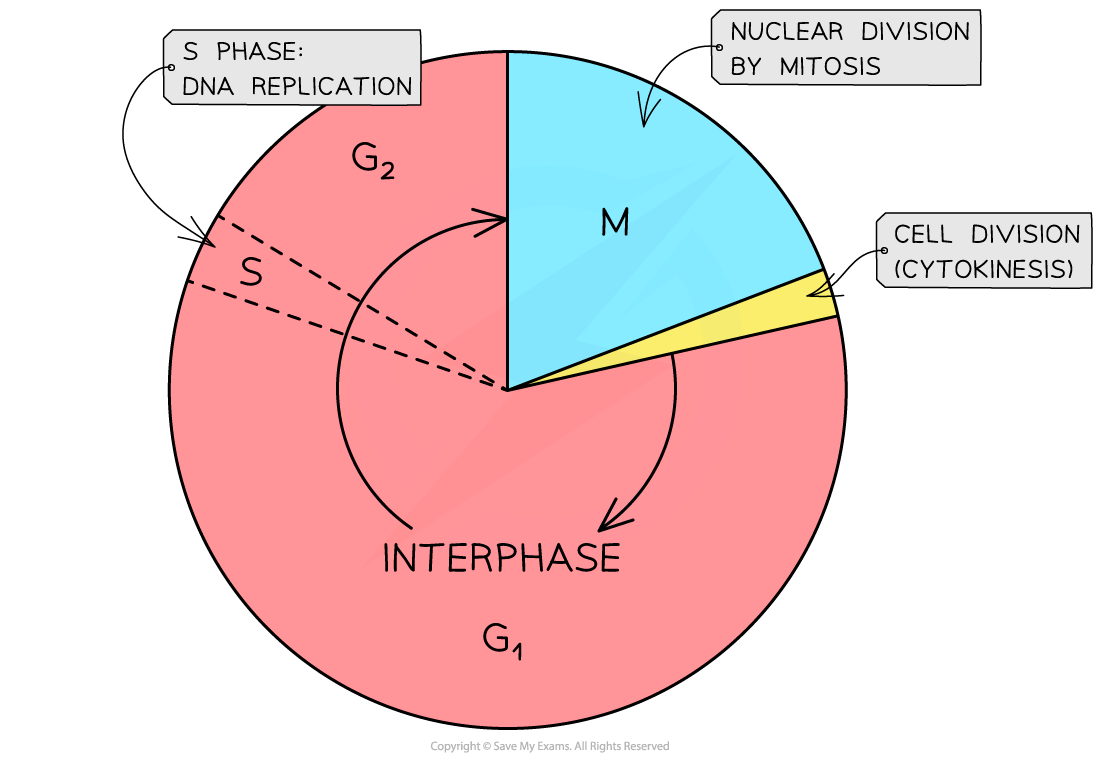The Cell Cycle & Mitosis (Edexcel International A Level Biology) : Revision Note
The Cell Cycle
Mitosis is part of a precisely controlled process known as the cell cycle
The cell cycle is the regulated sequence of events that occurs between one cell division and the next
The cell cycle has three phases:
Interphase
Nuclear division (mitosis)
Cell division (cytokinesis)
The length of the cell cycle is very variable depending on environmental conditions, the cell type and the organism
For example, onion root tip cells divide once every 20 hours (roughly) but human intestine epithelial cells divide once every 10 hours (roughly)
The movement from one phase to another is triggered by chemical signals called cyclins

The stages of the cell cycle
Interphase
During Interphase the cell increases in mass and size and carries out its normal cellular functions, e.g. synthesising proteins and replicating its DNA ready for mitosis
Interphase consists of three phases:
G1 phase
S phase
G2 phase
It is at some point during the G1 phase that a signal is received telling the cell to divide again
The DNA in the nucleus replicates (resulting in each chromosome consisting of two identical sister chromatids)
This phase of the interphase stage of the cell cycle is called the S phase – S stands for synthesis (of DNA)
The S phase is relatively short
The gap between the previous cell division and the S phase is called the G1 phase – G stands for gap
Cells make the RNA, enzymes and other proteins required for growth, as well as replicating organelles during the G1 phase
Between the S phase and next cell division event the G2 phase occurs
During the G2 phase, the cell continues to grow and the new DNA that has been synthesised is checked and any errors are usually repaired
Other preparations for cell division are made (e.g. production of tubulin protein, which is used to make microtubules for the mitotic spindle)
Interphase = G1 + S + G2
Nuclear division (mitosis)
Follows interphase
Referred to as the M phase – M stands for mitosis
Cell growth stops during the M phase
During mitosis, the two identical sister chromatids of each chromosome separates from each other and move to opposite poles of the cell
This ensures that each new nucleus that forms will contain the exact same genetic information as the original nucleus
Cytokinesis
Follows M phase
Once the nucleus has divided into two genetically identical nuclei, the whole cell divides and one nucleus moves into each cell to create two genetically identical daughter cells
In animal cells, cytokinesis involves constriction of the cytoplasm between the two nuclei and in plant cells a new cell wall is formed
Examiner Tips and Tricks
Make sure you know the order of the phases of the cell cycle but also what specifically occurs during the different phases. Don’t forget, interphase is itself made up of three distinct stages (G1, S and G2) and you need to know what happens during each of these.
For example, an exam question might ask you to identify the stage of the cell cycle during which a cell would be producing the most mRNA molecules and explain why. The correct answer would be the G1 phase, as this is when protein synthesis is occurring and the production of mRNA occurs during transcription (the first part of protein synthesis).
Mitosis
Mitosis is the process of nuclear division by which two genetically identical daughter nuclei are produced that are also genetically identical to the parent cell nucleus (they have the same number of chromosomes as the parent cell)
Although mitosis is, in reality, one continuous process, it can be divided into four main stages
These stages are:
Prophase
Metaphase
Anaphase
Telophase
Most organisms contain many chromosomes in the nuclei of their cells (eg. humans have 46) but the diagrams below show mitosis of an animal cell with only four chromosomes, for the sake of simplicity
The different colours of the chromosomes are just to show that half are from the female parent and half from the male parent
Prophase
Chromosomes condense and are now visible when stained
The chromosomes consist of two identical chromatids called sister chromatids (each containing one DNA molecule) that are joined together at the centromere
The two centrosomes (replicated in the G2 phase just before prophase) move towards opposite poles (opposite ends of the nucleus)
Spindle fibres (protein microtubules) begin to emerge from the centrosomes (which consist of two centrioles in animal cells)
The nuclear envelope (nuclear membrane) breaks down into small vesicles

Prophase stage of mitosis where chromosomes condense into visible structures
Metaphase
Centrosomes reach opposite poles
Spindle fibres (protein microtubules) continue to extend from centrosomes
Chromosomes line up at the equator of the spindle (also known as the metaphase plate) so they are equidistant to the two centrosome poles
Spindle fibres (protein microtubules) reach the chromosomes and attach to the centromeres
Each sister chromatid is attached to a spindle fibre originating from opposite poles

Metaphase, where chromosomes line up along the equator of the cell
Anaphase
The sister chromatids separate at the centromere (the centromere divides in two)
Spindle fibres (protein microtubules) begin to shorten
The separated sister chromatids (now called chromosomes) are pulled to opposite poles by the spindle fibres (protein microtubules)

Anaphase, where chromosomes are pulled to the poles of the cell
Telophase
Chromosomes arrive at opposite poles and begin to decondense
Nuclear envelopes (nuclear membranes) begin to reform around each set of chromosomes
The spindle fibres break down

Telophase, where the nuclei reform and the cell begins to split into two
The significance of mitosis
The process of mitosis is of great biological significance and is fundamental to many biological processes, including:
The growth of multicellular organisms
The replacement of cells and repair of tissues
Asexual reproduction
Growth of multicellular organisms
The two daughter cells produced are genetically identical to one another (clones) and have the same number of chromosomes as the parent cell
This enables unicellular zygotes (as the zygote divides by mitosis) to grow into multicellular organisms
Growth may occur across the whole body of the organism or be confined to certain regions, such as in the meristems (growing points) of plants
Replacement of cells & repair of tissues
Damaged tissues can be repaired by mitosis followed by cell division
As cells are constantly dying they need to be continually replaced by genetically identical cells
In humans, for example, cell replacement occurs particularly rapidly in the skin and the lining of the gut
Some animals can regenerate body parts, for example, zebrafish can regenerate fins and axolotls regenerate legs and their tail amongst other parts
Asexual reproduction
Asexual reproduction is the production of new individuals of a species by a single parent organism – the offspring are genetically identical to the parent
For unicellular organisms such as Amoeba, cell division results in the reproduction of a genetically identical offspring
For multicellular organisms (as seen with many plant species) new individuals grow from the parent organism (by cell division) and then detach (‘bud off’) from the parent in different ways. Some examples of these are budding in Hydra and yeast and runners from strawberries
Examiner Tips and Tricks
Make sure you learn the four stages of mitosis. Cytokinesis is often mistaken as a stage of mitosis, but remember this is a separate part of the cell cycle.
The acronym PMAT can be helpful to remind you what happens during each stage of mitosis:
P = Prophase, where the cell Prepares to divides
M = Metaphase, where the chromosomes align along the Middle
A = Anaphase, where the chromosomes move Away from each other
T = Telophase, where Two nuclei reform
The chromosome number is important too; after interphase but before the parent cell undergoes mitosis, the human parent cell nucleus actually contains 92 DNA molecules! This is because during interphase (S phase), the 46 DNA molecules in the parent cell have replicated to form sister chromatids. As human cells have a diploid number of 46 this replication results in 92 molecules. This ensures the two daughter cells will be diploid (have 46 chromosomes each) when mitosis occurs. Remember to read the questions carefully as only human diploid cells have 46 chromosomes so if the question refers to another organism, its diploid number will be different.

You've read 0 of your 5 free revision notes this week
Sign up now. It’s free!
Did this page help you?
